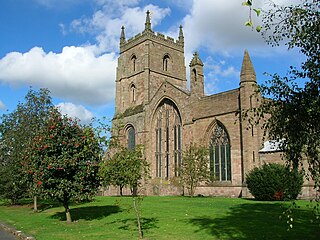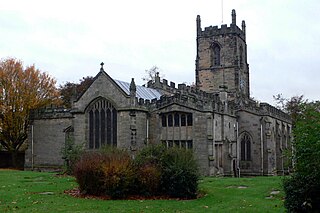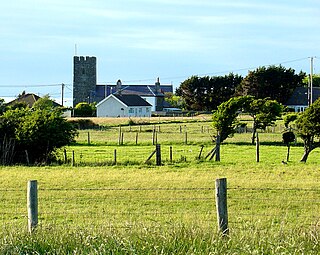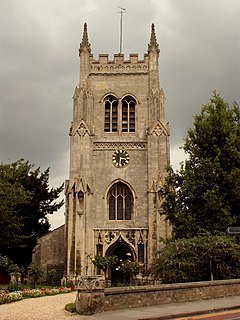Robert Bloet was Bishop of Lincoln 1093-1123 and Chancellor of England. Born into a noble Norman family, he became a royal clerk under King William I. Under William I's son and successor King William II, Bloet was first named chancellor then appointed to the See of Lincoln. Continuing to serve the king while bishop, Bloet remained a close royal councillor to William II's successor, King Henry I. He did much to embellish Lincoln Cathedral, and gave generously to his cathedral and other religious houses. He educated a number of noblemen, including illegitimate children of Henry I. He also was the patron of the medieval chronicler Henry of Huntingdon, and was an early patron of Gilbert of Sempringham, the founder of the Gilbertine monastic order.
Maxstoke is a hamlet in the North Warwickshire district of the county of Warwickshire, England.
Westwood Priory was a priory of Benedictine nuns founded in 1153, near Droitwich, Worcestershire, England. It was a daughter house of Fontevraud Abbey, seized by the English crown in 1537 during the Dissolution of the monasteries.

The Priory Church is an Anglican parish church in Leominster, Herefordshire, England, dedicated to Saint Peter and Saint Paul. The building was constructed for a Benedictine Priory in about the 13th century, although there had been an Anglo-Saxon monastery in Leominster, possibly on the same site. In 1539 the east end of the church was destroyed along with most of the monastic buildings, but the main body of the church was preserved.

The Priory Church of St Mary, Abergavenny is a parish church in the centre of Abergavenny in Monmouthshire, Wales.

Hurley Priory is a former Benedictine priory in the village of Hurley on the banks of the River Thames in the English county of Berkshire.

St Oswald's Priory was founded by Æthelflæd, daughter of Alfred the Great, and her husband Æthelred, ealdorman of Mercia, in the late 880s or the 890s.
Stonely Priory was an Augustinian priory in Cambridgeshire, England. It was dissolved in 1536.
Boston Priory was a priory in Boston, Lincolnshire, England.

Deeping St James Priory was a priory in Deeping St James, Lincolnshire, England. In 1139 Baldwin Fitz Gilbert established the Benedictine Priory of Saint James at Deeping as a cell of Thorney Abbey. The cell was dissolved at the surrender of Thorney in 1539. The priory church remains as the Church of England parish church of Deeping St James and is a Grade I listed building.
Great Limber Priory, Limber Magna was a priory in Great Limber, Lincolnshire, England.
Long Bennington Priory was a priory in Lincolnshire, England.

St Leonard's Priory, Stamford was a priory in Lincolnshire, England. It was built in Stamford, supposedly on the site of a monastery which was founded by St Wilfrid in 658 and destroyed in the Danish invasion.

Nuneaton Priory was a medieval Benedictine monastic house in Nuneaton, Warwickshire, England, initially founded in 1153 at Kintbury in Berkshire and was a daughter house of Fontevraud Abbey.

St Helen's Church is the Anglican parish church of Ashby-de-la-Zouch, in the deanery of North West Leicestershire and the Diocese of Leicester. There was a church in the town in the 11th century, but the core of the present building mainly dates from work started in 1474, when the church was rebuilt by William Hastings at the same time that he converted his neighbouring manor house into a castle. The church was refurbished in about 1670 to create more space, but the large and increasing size of the congregation led to further work in 1829, and a major rebuild in 1878–80, including the widening of the nave by the addition of two outer aisles.

Church of St Thomas of Canterbury is a parish church and Grade I listed building in Clapham, Bedfordshire, England. It became a listed building on 13 July 1964. Though the church can be traced back before A.D. 1000, there is no record of the original patron saint, Thomas Becket having been so well accepted. The church is built in the Saxon style, possibly early 10th century. There are narrow semi-circular-headed windows. The upper story is Early Norman. The parapet is 17th century. The remainder of the church was entirely rebuilt in 1861, by Sir George Gilbert Scott. It features a chancel, nave, and two aisles. The tower, which dates to the 11th or 12th centuries, measures 26 metres (85 ft) in height.

Llansantffraid or Llansantffraed is a small rural village and community and practically merged with the village of Llanon just west of the main A487 Coastal Road between Aberaeron and Aberystwyth, about eleven miles from Aberystwyth. The population in 2001 was 1,241, declining to 1,212 at the 2011 census.














